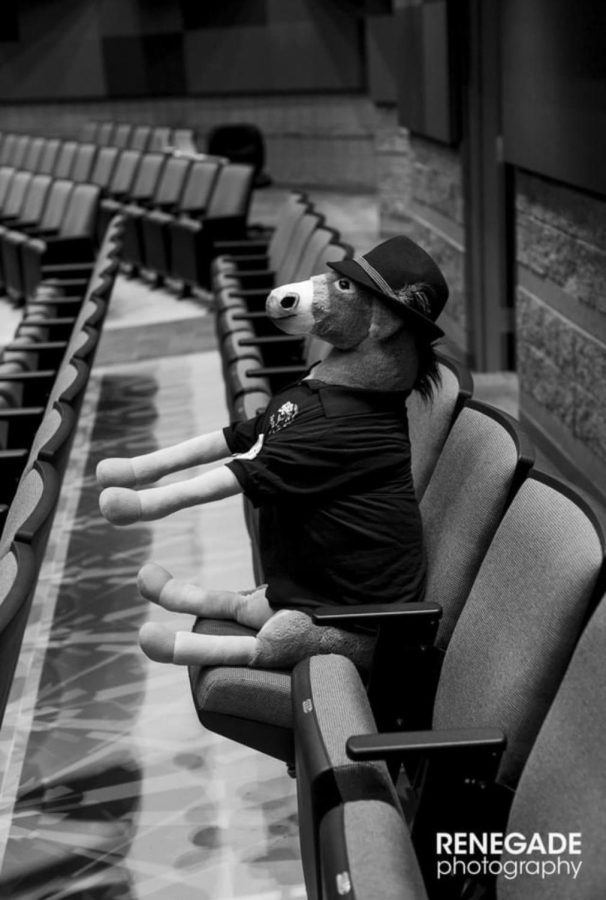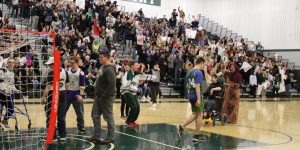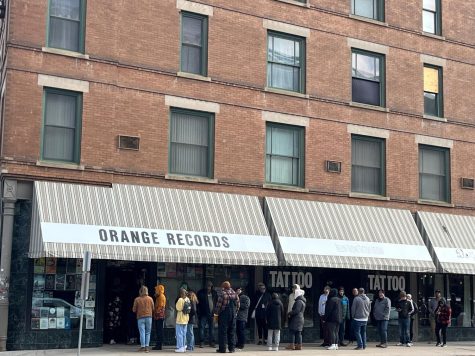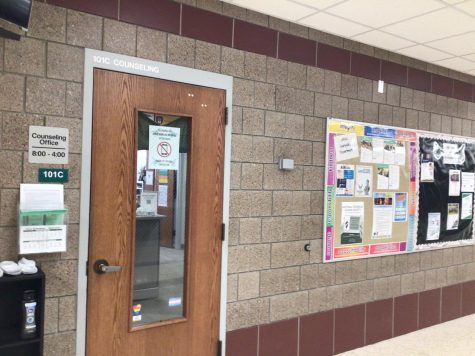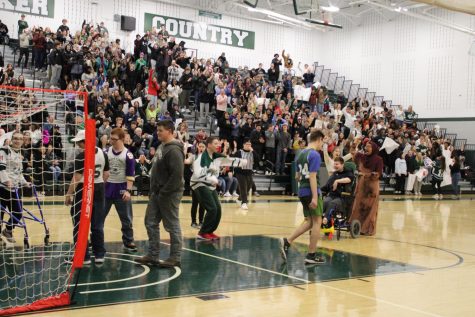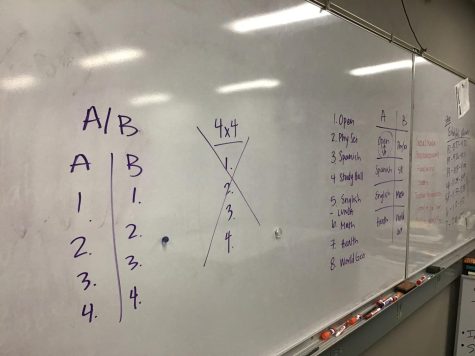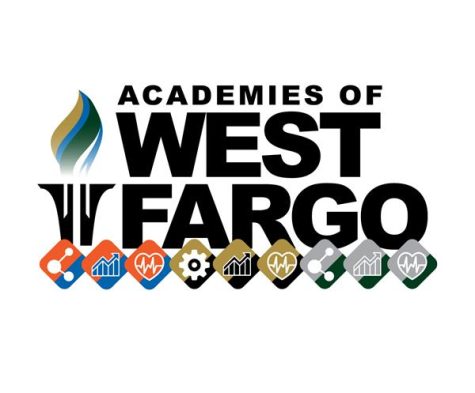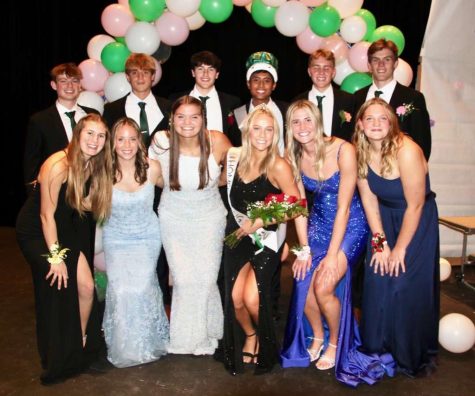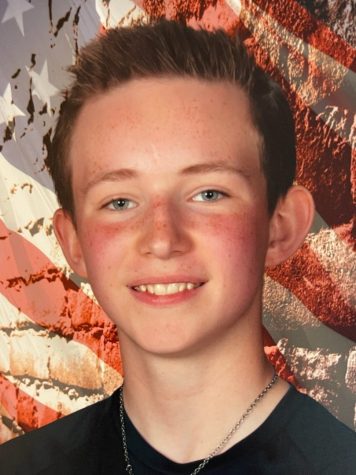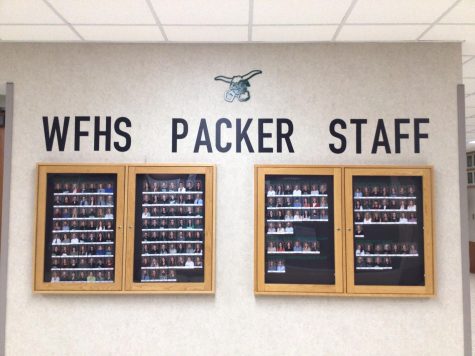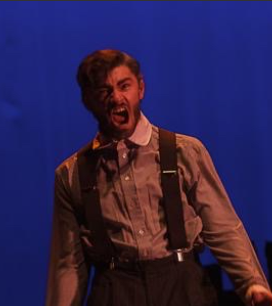The Unseen Art of Tech Theatre
Photo taken by Renegade Photography
September 22, 2022
The spectacle of a theatre production is second to none. Going to the theatre is a magical experience in a lot of ways, but the actors on stage are only half of what creates that magic. So much goes on backstage, in the catwalks and in the booth that sometimes go unnoticed. Tech is an important part of theatre, and more people need to be aware of what the technicians do within the art. Everything they do you can see on the stage, but the process of getting those things onto the stage is sometimes more complicated than you think.
Kerry Horst, the director for the fall musical and the tech director here at West Fargo Public School. He is a professional in tech theatre and has been in the field for over a decade. He oversees the tech departments of all six schools in the area. “Technology always needs to be an enhancement, it can never be a show stealer,” says Horst. As the tech director he also has a lot of solve a lot. “Whether its long-term problem solving like I’m working on right now trying to figure out how we’re going to stage Pippin. Or the extremely short term, like an actor missed a line we need to jump a cue in the music.” Overall, the creation process is more fun for the tech director in educational theatre because he doesn’t run the booth during shows. Being a tech director for many years has given Horst a different perspective now that he’s back doing stage directing as well. His knowledge of directing is of both tech and acting, which helps him connect with the actors and tech kids alike.
The thing most people imagine when they think of tech theatre is the lights. It’s the area of theatre that is most visible because it makes everything visible. The first element of light design is making sure the actors are seen, then the tech crew looks at the script for each scene and ask themselves, “what is the environment? Time of day? The mood?” After those questions are answered, they figure out where to hang and position the lights so that they hit the set or the actors in a flattering way. A typical high school show will have 100 – 250 lighting instruments. With all those lights, Horst sets aside 20 to 40 hours just for programming, but depending on the show, the programming time can be double or quadruple that amount.
The next step is hanging lights in the catwalks. Horst will figure out where he needs light, then he spots from the stage which area in the catwalks would be best to place that light. In the catwalks there is a pipe that the lights go on. Whoever is hanging the light gets it onto the pipe and secures it down. Once the light is up, they can aim it in whatever direction they need and focus it to cover the area it needs to. Colors can be added to lights with color gels or LEDs. “It is sometimes very subtle. You can look at like ten different blues and select some. One blue and another blue will look nearly identical when you look at it just holding it up to the light, but elicits very different feelings,” Horst explains. The lights make the audience subconsciously feel certain emotions and set a certain mood. Lights are not just so that the actors are seen, they bring you into the story and connect you with the characters.
Plays don’t have designs as complicated as musicals. The musical numbers need more pizazz and since plays don’t have musical numbers, the light plots aren’t as intricate. “Say, for example, the show I did at Horace high school last year… there were periods where there was something like 20 or 30 light cues in the span or like a minute. You don’t usually have that kind of thing in a play,” Horst says.
Speaking of musical numbers, sound is a crucial part of a production. Tim Kraft is a sound designer for the WFHS theatre. He has been doing tech for about three years and has become very skilled at his job. So much so that he now has an internship with the school. As a sound designer he finds sounds to use based on what’s in the script as well as making sure everything sounds good. He tries to make the microphones sound clear and “not crunchy” by changing effects or how the audio is sent to the speakers. Kraft comments, “There is not a visual way to view sound design in my opinion. For me it is how something sounds and how those sounds can affect someone’s emotions or their senses.” The sound design is different depending on if it’s for a play or a musical. Plays at WFHS don’t have any mics, but for musicals every person onstage has a mic. This makes plays simpler to design for because the only things they have to prepare are the sound effects. Musicals, however, have a lot more going on within sound. The sound board operator has to work with more mic channels than they can even see at one time, which makes it a lot more difficult. But overall, in a musical you need sound because without it, the pit wouldn’t be heard as clearly, the actors would be hard to hear at times, and the big and flashy spectacle of a musical number wouldn’t be there. Programming for sound is different from lights. On the sound board they have to switch out which mics are visible constantly to keep up with the cues, while the lights have to press the GO button to start the program. Horst says that skipping cues is more difficult for sound than lights because as long as there is light in the spot it needs to be, people won’t notice. However, for sound if a cue is missed and an actors microphone isn’t turned on, everyone will notice.
In order to keep the production running smoothly, both tech crew and actors defer to the stage manager. You don’t directly see what a stage manager does, but everything onstage is kept under control because of their work. Alessa Herrera Grant is the stage manager at WFHS this year. She is at every rehearsal, taking notes, taking attendance and doing any jobs the director needs. The best and worst part of being a stage manager according to Herrera Grant is that she has to be there everyday. She loves getting to interact with everyone, but it takes a lot of work and time to do what she does. She says, “Every actor has told me that they would be lost without a stage manager, so I guess I’m a valuable part.” This is a big understatement. A stage manager keeps everyone on track, where they need to be, and knowing what they need to do. Even the small things like calling “places” after intermission. Without that simple call there would be chaos backstage. Herrera Grant says there’s a good balance of having to corral and control the actors backstage and having the actors know exactly what they’re doing. However, sometimes people aren’t where they’re supposed to be. She explains, “Some of the actors are very nice. They’re there backstage right when they have to enter, and they know their entrances, but sometimes you do have to corral them.” In this case the stage manager has to run to find them while the actors onstage stall. Once the actors are onstage, the stage manager still has a lot to keep track of. If something goes wrong onstage all they can do is make note of it and fix it during intermission or a scene change. Through all the chaos of a production the stage manager has to stay calm. If they lose their head, everything can become a train wreck. As much chaos goes on backstage, Herrera Grant says, “The actors are really mature and they know what to do and when to do it, so I can sit back and relax sometimes.”
Props managers add realism and life to productions through objects, which make the set and characters actions seem more believable. Thomas Sikorski cares for and manages the props for all the productions. He has been leading props for about three years. This is what he says on the area of props, “Props are the thing that kind of draw people in and make it seem more like everyday life.” Imagine watching a production and a character goes to pick up the phone, but there’s no phone. That brings you out of the experience because it doesn’t look real. Sikorski says that he classifies a prop as any inanimate object the actors bring onstage or interact with, even the set. Hand props are the small objects that actors can hold and carry and stage props that are things the actors can’t move around the stage. As the props student leader, Sikorski makes lists of needed props after reading though the script, then talks to the director to confirm that list. After that he must search the props loft, contact other schools, order online, or props technicians create the items themselves.
Usually if a prop needs to be created it’s because that item is hyper specific to that show. “In Little Women for example, I had to make a Victorian kite, so that they could fly that around the theatre,” says Sikorski. Something like that would be very hard to come by, so research goes into the item and the best way to create it. Multiples of the props are created as spares if anything breaks or goes wrong. Although in some cases the props are supposed to break. Sikorski commented, “Last year we spent a total of 18 hours making bird cages.” This was for “Sweeney Todd” when one of the characters smashes a birdcage on the ground in anger. Every tech run and show he needed to have a bird cage to smash, so lots of cages were made just to be destroyed. Meanwhile, the props already in the prop loft also need to be managed. There are lists upon lists of what props are being used, where they came from, and if they are confirmed for use or not. Lists help keep everything organized, especially when there are multiple people working in props. The organization methods in the prop loft, however, are not as straightforward. Sikorski says, “The best way I’ve found to organize the prop loft is put absolutely everything away once, and then you know where absolutely everything is.” People with the most experience in the loft know where things are, but someone new to props would have to familiarize themselves in order to find anything. All in all, props may seem like just small objects, but there is a lot more that goes into them. Props need to be kept up with throughout tech and show weeks. Sikorski says, “The thing about props is the fact that your job’s not done once all the stuff is made.”
A lot of work and thought goes into what a character looks like on stage. Costumes are critical to a production, especially if it’s a period piece. The clothing on the actors must remain true to the time period of the show. The costume room in the theatre wing is stocked full of clothes from medieval times, to the 1800’s to the 2000s. Emily Spadafore is one of the two main costume technicians from last year. Without people like her backstage the productions would lack character and be a little confusing. If a character from the 1800s came out wearing leggings and a T-shirt the production would be unrealistic and incorrect. No costumes would also mean that the style of the character would depend on the style of the actor. To make sure that doesn’t happen, Spadafore and the costume technicians have to pick out costume pieces that fit the time and the characters. This can be difficult because most actors have multiple costumes, especially ensemble. That’s a lot of people who need multiple outfits to wear. To do that, the costume technicians have to take all their measurements, get the costumes chosen, and prepared in an organized and efficient fashion. The ensemble mostly looks the same, but the leads have costumes that catch your eye a bit more. This way your attention is drawn to them, and you don’t lose them in a crowd. Characterization is big for lead characters as well because they have distinct personalities, whereas the ensemble is supposed to blend in more. Costume technicians have to be able to fix pieces as well as find them. “We’ve had to sew costumes because zippers break, stuff tears, pants don’t fit somebody,” says Spadafore. The costumes have to be sturdy enough to stay together through dancing, dramatic breakdowns, and everything else that goes down onstage. Once those costumes are ready for the stage, the chaos still isn’t over. Breaks and tears happen during shows as well as rehearsals. In this case Spadafore comments, “safety pins are our best friend.” It’s the quickest option for the time constraints of a live show. It might not look the prettiest, but it’s better than no costume at all. Once the show is over, the costumes go back into the costume room. Spadafore says, “It’s a really small space for a lot of costumes, and if there’s one thing we need more of, its hangers.”
Hair and makeup technicians are key to making sure everyone looks show ready. The hair and makeup in a production is critical to characterization. The time period, character traits, and script are all things that affect how a character looks. For example, when WFHS put on productions of “Sweeney Todd” last fall, one of the main characters, Johanna, has blonde hair but the actress, Katie Sikorski, has dark hair. A wig was used to give her the blonde hair that is a vital part of her character and the story. Sometimes hair and makeup technicians can take artistic liberties, but in cases like Johanna, the blonde hair had to stay. When it comes to hair and makeup Elizabeth Ista, a hair and makeup technician, says, “I like to think of hair and makeup as an extension of the character’s costumes. Without it the characters would look incomplete or, in some cases, unrecognizable.” To make a character who is older not look like a high schooler, hair and makeup technicians add wrinkle lines, grey hair, and in some cases, they contour cleavage to make girls look older.
Makeup works closely with costumes to make sure they not only avoid a disconnect but can enhance the look overall. Both areas have to research the time period to find trends and what was available to people, especially for makeup in period pieces. “Artistic liberties are taken constantly because you have to see what works for the individuals’ skin or hair, but also what does and doesn’t work onstage,” says Ista. There are things that must be kept consistent to the period, but changes are sometimes necessary. To look good onstage the actors, must wear stage makeup, which is a lot heavier than your everyday look. Ista comments on the reason for this, “The stage lights can make you look extremely pale and wash out facial features.” To make sure no one gets washed out on stage, the makeup technicians look at everyone from a distance and check that the basic makeup criteria is met. A lot of product is used when putting on stage makeup because of the fact that it has to be bold enough to see all the way across the theatre. To put that in perspective, about 5 pans of blush are used per musical. That’s a lot of blush.
Making a set is the most time consuming and labor-intensive part of making a production; everyone must come together to create the setting for their story. The blueprints for the set are bought from set designers and altered in any way needed to fit the stage and director’s creative vision. There are lots of things that go into designing a set for a specific show. Every production is different and in turn every set is different. In the end it gets taken down and it’s a visual way to tell that the show is over. With all the different elements accounted for, there will be nothing quite like that production with those people ever again.
Sometimes kids who are actors also do tech, like most of our props, costume, hair, and makeup technicians. Sikorski says, “I’ve got to know people on the tech crew a lot more personally than I would have if I was just in the cast.” Spadafore says, “You need to have that connection and communication otherwise it’s not going to go well.” Tech kids and actors need to interact when they can because tech kids aren’t there all the time. Building that community is a huge part of theatre in general and without it the shows wouldn’t have as much fun and life in them. Something that both actors and tech kids find joy in is the mascot, Donkey. You might wonder what a stuffed animal donkey could do for a community, but he sure has strengthened this one. Having that common joy and something that everyone loves brings things together. Kraft says, “Donkey became more of an icon and a way to add humor and joy to the theaters, something everyone needs.”
Technical theatre gives the technicians a challenge in whatever field they’re in. Whether it’s making props for a Victorian era show, creating a light design that fits the story and the set, or managing the actors backstage. Productions just wouldn’t be the same without the amazing art of technical theatre. Every technician mentioned in this article said that if you’re thinking about joining tech, just try it, because experiencing it is a lot different than reading about it. It’s unlike any other activity or club in the school. Theatre itself is completely unique and a completely amazing experience. It’s a big commitment, and a lot of work, but anyone who joins will have an experience that will last a lifetime.




